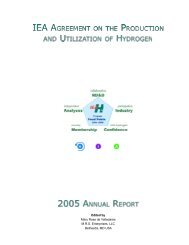Review of Small Stationary Reformers for Hydrogen Production
Review of Small Stationary Reformers for Hydrogen Production
Review of Small Stationary Reformers for Hydrogen Production
You also want an ePaper? Increase the reach of your titles
YUMPU automatically turns print PDFs into web optimized ePapers that Google loves.
at refueling stations), but scale economies in the capital cost are significant. The capital<br />
cost is about $750/kW H2 at 1 million scf/day and $4000/kW H2 at 0.1 million scf/day.<br />
<strong>Small</strong>-scale conventional (long tube, high temperature) steam methane re<strong>for</strong>mers are<br />
commercially available from a number <strong>of</strong> companies, which normally produce large steam<br />
methane re<strong>for</strong>mers <strong>for</strong> chemical and oil industries. The main design constraints <strong>for</strong> these<br />
systems are high throughput, high reliability and high purity (depending on the application.<br />
Companies supplying this type <strong>of</strong> re<strong>for</strong>mer include Haldor-Topsoe, Howe-Baker,<br />
Hydrochem, KTI, and Foster Wheeler.<br />
The disadvantages <strong>of</strong> conventional long tube steam re<strong>for</strong>mers <strong>for</strong> hydrogen refueling station<br />
applications are their large size (12-meter long catalyst-filled tubes are is commonly used),<br />
and high cost (which is due to costly materials requirements <strong>for</strong> high temperature, high<br />
pressure operation, and to engineering/installation costs <strong>for</strong> these one <strong>of</strong> kind units). For<br />
these reasons, it is generally believed in the hydrogen and fuel cell R&D communities that a<br />
more compact, lower cost re<strong>for</strong>mer will be needed <strong>for</strong> stand-alone hydrogen production at<br />
refueling stations (Ogden et al. 1996; Thomas et al. 1997).<br />
b. Compact “Fuel Cell Type” Steam Methane <strong>Re<strong>for</strong>mers</strong> with Concentric Annular<br />
Catalyst Beds<br />
At small sizes, a more cost effective approach is to use a lower pressure and temperature<br />
re<strong>for</strong>mer, with lower cost materials. Steam methane re<strong>for</strong>mers in the range 2000 to 120,000<br />
scf H2/day have been developed <strong>for</strong> use with fuel cells, and have recently been adapted <strong>for</strong><br />
stand-alone hydrogen production (Halvorson et. al 1997). In these systems, the heat transfer<br />
path is curved (see Figure 7b), to make the device more compact, and the re<strong>for</strong>mer<br />
operates at a lower temperature and pressure (3 atm, 700°C), which relaxes materials<br />
requirements. Estimates <strong>of</strong> mass produced costs <strong>for</strong> small “fuel cell type” steam methane<br />
re<strong>for</strong>mers indicates that the capital cost <strong>for</strong> hydrogen production plants in the 0.1 to 1.0<br />
million scf/day range would be $150-$180/kW H2 assuming that 1000 units were produced<br />
(DTI et al. 1997). (Costs are given on a higher heating value basis, and <strong>for</strong> the purpose <strong>of</strong><br />
comparison, do not include hydrogen compression, storage or dispensing to vehicles.) The<br />
capital costs per unit <strong>of</strong> hydrogen production ($/kW H2) are similar <strong>for</strong> fuel cell type small<br />
re<strong>for</strong>mers and conventional, one-<strong>of</strong>-a-kind large re<strong>for</strong>mers, assuming that many small units<br />
are built. Energy conversion efficiencies <strong>of</strong> 70%-80% are possible <strong>for</strong> these units.<br />
A number <strong>of</strong> companies have developed compact steam methane re<strong>for</strong>mers to re<strong>for</strong>m<br />
natural gas <strong>for</strong> closely coupled fuel cells. These include Haldor-Topsoe, International Fuel<br />
Cells (IFC), Ballard Power Systems, Sanyo Electric, and Osaka Gas Company.<br />
� Praxair, in a joint venture with IFC, has recently commercialized a small stand-alone<br />
hydrogen production system based on this type <strong>of</strong> re<strong>for</strong>mer (Halvorson et al. 1997).<br />
� Researchers at the Fraunh<strong>of</strong>er Institute <strong>for</strong> Solar Energy Systems are designing a more<br />
compact multi-tube steam methane re<strong>for</strong>mer with a catalytic heater rather than a burner<br />
(Vogel et al. 1998).<br />
� Energy Partners is building residential PEMFC power system (Barbir et al. 2000).<br />
Franh<strong>of</strong>er Institute (Vogel et al. 1998) built methane re<strong>for</strong>mers to make H2 <strong>for</strong> use with<br />
Energy Partners vehicle.<br />
9













